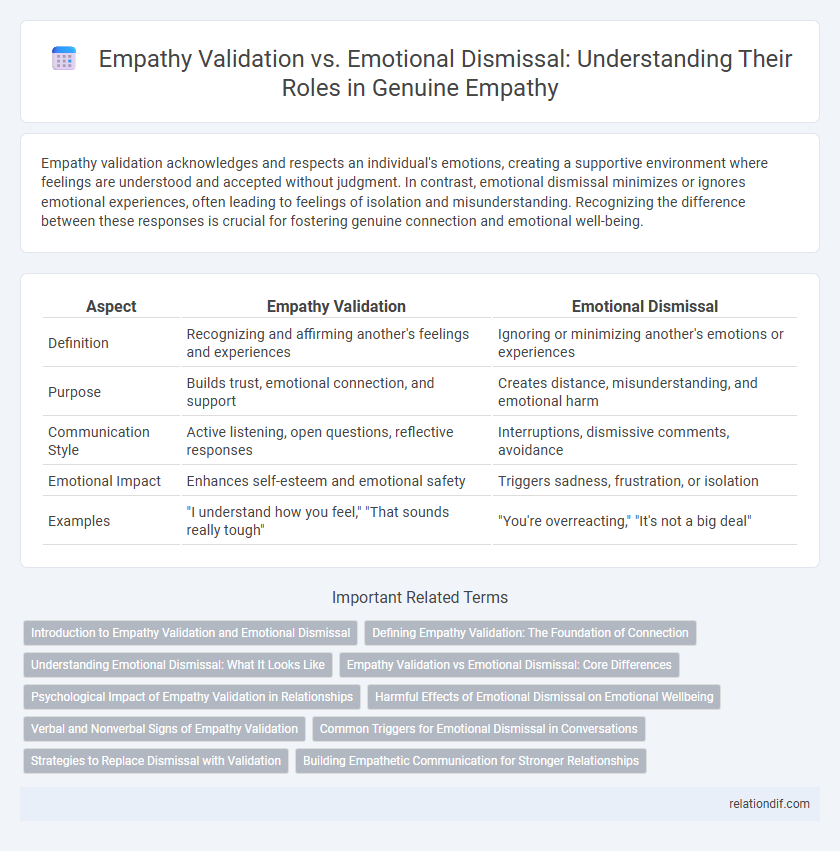Empathy validation acknowledges and respects an individual's emotions, creating a supportive environment where feelings are understood and accepted without judgment. In contrast, emotional dismissal minimizes or ignores emotional experiences, often leading to feelings of isolation and misunderstanding. Recognizing the difference between these responses is crucial for fostering genuine connection and emotional well-being.
Table of Comparison
| Aspect | Empathy Validation | Emotional Dismissal |
|---|---|---|
| Definition | Recognizing and affirming another's feelings and experiences | Ignoring or minimizing another's emotions or experiences |
| Purpose | Builds trust, emotional connection, and support | Creates distance, misunderstanding, and emotional harm |
| Communication Style | Active listening, open questions, reflective responses | Interruptions, dismissive comments, avoidance |
| Emotional Impact | Enhances self-esteem and emotional safety | Triggers sadness, frustration, or isolation |
| Examples | "I understand how you feel," "That sounds really tough" | "You're overreacting," "It's not a big deal" |
Introduction to Empathy Validation and Emotional Dismissal
Empathy validation involves recognizing and affirming another person's feelings and experiences, fostering trust and emotional connection. Emotional dismissal occurs when someone's feelings are ignored, minimized, or invalidated, often leading to increased distress and relational strain. Understanding the difference between empathy validation and emotional dismissal is crucial for effective communication and emotional support.
Defining Empathy Validation: The Foundation of Connection
Empathy validation involves recognizing and affirming another person's emotions, creating a safe space for authentic expression and fostering trust. It differs from emotional dismissal, which minimizes or ignores feelings, often leading to disconnection and misunderstanding. As the foundation of connection, empathy validation promotes emotional healing and strengthens interpersonal relationships.
Understanding Emotional Dismissal: What It Looks Like
Emotional dismissal occurs when a person's feelings are minimized, ignored, or invalidated, signaling a lack of acknowledgment for their emotional experience. Common signs include statements like "You're overreacting" or "It's not a big deal," which can shut down open communication and deepen emotional distress. Recognizing these behaviors is crucial for fostering empathy and creating a supportive environment where emotions are respected and validated.
Empathy Validation vs Emotional Dismissal: Core Differences
Empathy validation involves actively listening, acknowledging emotions, and conveying understanding, which fosters trust and emotional safety. Emotional dismissal minimizes or ignores feelings, leading to disconnection and increased emotional distress. The core difference lies in validation affirming experiences, while dismissal invalidates and undermines emotional expression.
Psychological Impact of Empathy Validation in Relationships
Empathy validation fosters trust and strengthens emotional bonds by acknowledging and affirming a partner's feelings, reducing feelings of isolation and enhancing psychological well-being. Studies show that empathy validation decreases anxiety and depressive symptoms, promoting resilience and effective communication within relationships. In contrast, emotional dismissal often leads to increased stress, emotional withdrawal, and deteriorated mental health, underscoring the critical role of empathy validation in sustaining healthy interpersonal connections.
Harmful Effects of Emotional Dismissal on Emotional Wellbeing
Emotional dismissal undermines emotional wellbeing by invalidating individuals' feelings, leading to increased stress, anxiety, and feelings of isolation. Unlike empathy validation, which fosters trust and emotional resilience by acknowledging and accepting emotions, emotional dismissal can exacerbate mental health issues and hinder emotional regulation. Prolonged exposure to emotional dismissal is linked to higher risks of depression and decreased overall psychological stability.
Verbal and Nonverbal Signs of Empathy Validation
Verbal signs of empathy validation include reflective listening, affirmations, and empathetic statements such as "I understand how you feel" or "That sounds really difficult." Nonverbal cues like sustained eye contact, nodding, open body posture, and gentle facial expressions reinforce emotional connection and show genuine concern. These behaviors foster trust and emotional safety, contrasting sharply with emotional dismissal marked by ignoring, interrupting, or minimizing feelings.
Common Triggers for Emotional Dismissal in Conversations
Common triggers for emotional dismissal in conversations include discomfort with intense feelings, fear of vulnerability, and a desire to quickly resolve conflicts without addressing underlying emotions. People may also dismiss emotions when they perceive expressions of feelings as exaggerated or irrational, or when cultural norms discourage open emotional expression. Recognizing these triggers is essential for fostering empathy validation, which involves acknowledging and respecting emotional experiences rather than minimizing or ignoring them.
Strategies to Replace Dismissal with Validation
Empathy validation strategies involve actively listening, acknowledging feelings, and reflecting emotions to foster a supportive environment, replacing emotional dismissal that often minimizes or ignores personal experiences. Techniques such as using open-ended questions, validating feelings without judgment, and offering compassionate responses help cultivate trust and emotional safety. Consistently practicing these approaches promotes healthier communication and strengthens interpersonal connections.
Building Empathetic Communication for Stronger Relationships
Empathy validation involves actively acknowledging and understanding another's feelings, fostering trust and deeper connection in relationships. Emotional dismissal, by contrast, negates or minimizes emotions, hindering open communication and weakening relational bonds. Building empathetic communication requires consistent recognition of emotions and thoughtful responses that validate experiences, promoting resilience and intimacy.
Empathy Validation vs Emotional Dismissal Infographic

 relationdif.com
relationdif.com